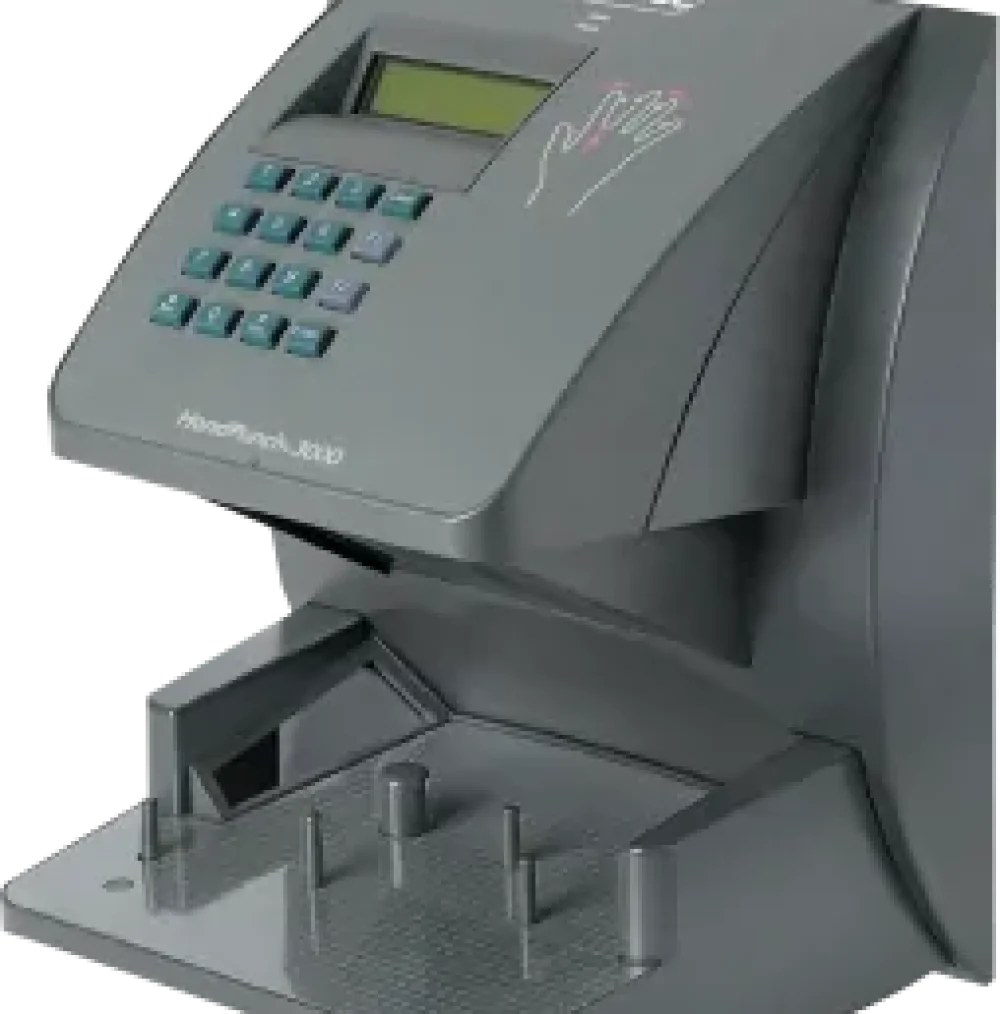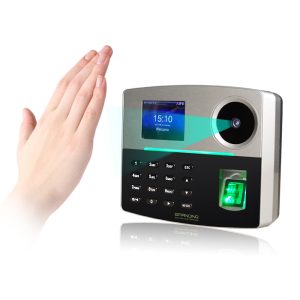Biometric Time Attendance: The Future of Time and Attendance Software

As time and technology advances, the time and attendance solution you use in your organization needs to be updated. Nowadays, a biometric time clock is seen as the best form of time and attendance software and will surely improve your bottom line.
Trading an individual’s time and talents for compensation has come a long way since the beginning of modern society; however, there have been a few bumps in the road along the way. One of the most troublesome bumps is the trust between employers and employees, specifically relating to tracking and documenting the duration of time spent on the job. Luckily for us, we live in the age of technology, and with advancements in scanners and database software comes the space age clocking in mechanisms we now call the biometric time clock.
Whether you’re a business owner or part of the management team, you’ll have to continue to adapt and fine-tune your methods. Best practices change quickly, and to run your business optimally, you’ll need to stay ahead of the game. We all know how fast technology is developed and pushed out into the market. It seems like every time you buy a brand new top of the line phone or a new computer, the next week it’s already obsolete!
Unfortunately, running a business can feel the same way. You’ve got everything set up and ready to go, only to find out you’re leaking cash like the Titanic. Biometric digital time clocks mend the holes in your business by holding employees accountable and securely monitoring their attendance.
So, what holes can be in your business? These issues come in many forms, and it’s hard to track them all. You may have talented employees working for you, but do they act and operate ethically? It’s human nature to try and get ahead, whether that’s by squeezing a little extra time on the clock, or having a buddy punch in for them since they’re “stuck in traffic.”
Aside from that, it’s sometimes in an employee’s best interest to work through their breaks to earn a little extra money, and although to an employee it may seem harmless, doing so opens you up to potential legal problems and labor law breaches. Traditional methods of clocking in won’t and don’t cut it if your plan is to run your business as optimally as possible and cover all of your bases.
Why you should switch to a biometrics time attendance solution
Remembering a password or RFID card to clock in can be cumbersome, and on the off chance an employee forgets the required password or card to clock in, that employee and his/her manager will be wasting precious time figuring out how to reset the password or replace the card.
Thankfully, biometric time clocks alleviate the problem of forgetfulness by requiring the employee to show up and bring their fingers! Assuming they never forget their fingers, and if they do you may have more problems than clocking in, biometric time clocks are a safe way to ensure employees are always capable of clocking in no matter the circumstances.
Moving past forgetting, passwords, and RFID cards aren’t nearly as secure as a biometric scanner and digital time clock. Passwords can be compromised by guessing or using advanced algorithms to crack them. RFID cards can be scanned and mimicked, allowing someone to create an identical card. Biometrics scanners, though, are incredibly difficult to trick.
You’ve probably seen in the movies where someone uses tape to pull a fingerprint off of a soda can that the person used hours ago. Scanners nowadays can identify when the image isn’t a finger, discarding those malicious attempts.
Biometric time clocks are the most secure way of employee time tracking without physically having someone log every action an employee takes. Even if you were willing to pay someone to do this, you’re now open to human error and the possibility that the person becomes compromised. With biometric time clocks, it’s safe to say you are using reliable, up-to-date technology.
How Biometric system works for attendance monitoring
Before we jump into discussing biometric identification, it’s important to note how unique a human fingerprint is. You’ve probably heard the notion that no two fingerprints are the same. While that’s not exactly true, it’s estimated there are roughly 64 billion patterns for a finger of similar dimensions. There are 7 billion people on the planet, so, the odds of having the same fingerprints as someone else in the same area as you with the same size fingers is incredibly small!
Biometric scanners come in several shapes and sizes, but they all perform roughly the same task. Biometric scanners feature a scanner behind a piece of glass that remembers patterns in the iris or finger. Once the recognized pattern has been input into the system’s memory, it’ll be there. From the employee’s side, starting the clocking in process with a biometric time clock takes a few seconds to set up on their first day, and they’re good to go for the duration of their employment.
Interested in the actual technology behind these scanners? Good, let’s talk about that. There are two types of scanners-
1) Optical Scanner
2) Capacitive Scanner
As far as optical scanners go, think about taking a photo using the flash module. The scanner shines a bright light generated by several LED’s over your finger and takes a snapshot using a highly sensitive microchip called a charge-coupled device (CCD) or a CMOS image sensor. The system will then upload this image, process it until only the details of the fingerprint are visible, and then using pattern-matching software the device will compare the scan with the contents of its database to ensure verification.
A capacitive scanner measures the finger electrically and maps out where your finger doesn’t connect with the sensor. Since there are different depths between each ridge on your finger, the scanner measures the distances to create a mathematical database of the landscape your finger contains. After the scanner has determined the required calculations, it compares the data to what’s inside the database; this is like what the latest mobile phones are utilizing!
If a scan is unable to determine whether or not the data it has collected from the finger is viable, a rescan should take place; this could happen for a number of reasons. The scanner could be dirty, the finger could be oily, something could be inhibiting the scanner from accurately measuring what it needs, the light in the room could be too bright resulting in a washed image or the light in the room could be too dim, not allowing the scanner to pick up enough detail to determine verification.
After a viable scan is confirmed, a timestamp is automatically assigned to the employee database server. The software will log the time until the employee scans again upon exiting the workplace, which then indicates the end of the duration of that employee’s shift. This process works well for tracking breaks and tracking irregular employee working hours, such as an employee having to leave for a personal emergency.
Why implement a biometric time clock

The terminal containing the scanner contains nifty software that easily records the second the scanner confirms the correct pattern and immediately assigns a timestamp to the pattern that coincides with the specific employee. No one can clock in for anyone else, eliminating buddy clocking and adding a high level of security to your operation; this way, you’ll be able to track every time Bob is “stuck in traffic” or Sally’s “alarm didn’t go off.”
Biometric time clocks can also grant or deny access to specific areas in your workplace. For example, if you’re managing an engineering firm whose projects are confidential and behind closed doors, you can set up a biometric system that only allows the employees to work on that specific project through the door, keeping your projects safe from peeping eyes.
We spoke about break time being cast aside earlier, but how exactly does biometric time clocking safeguard your business from such actions? Since the biometric time clock accurately records each employee’s timestamps in real-time, the software can notify an individual who has overworked and needs to clock out for a break; this not only saves your company money but also provides a safety net between you and a courtroom. Not all employees fully understand labor laws, and that’s okay as long as you have a way to remind them and hold them accountable!
Furthermore, saving time is always a huge advantage, and by utilizing a biometric scanner in tandem with the best time clock app and software suite, a plethora of benefits become available.
First, empower employees by giving them the ability to actively see their own timestamps. Staff members won’t need to ask how much time they’ve logged, as it will be available for them to check.
Even better, employees using biometric time clocks can clock in and out much quicker than having to record their times or having a manager record the time manually. Walking up to the scanner, placing their finger on the scanner, and leaving, allows for quicker shift changes and faster clock in’s, enabling employees to cycle much more effectively and get on/off the job in a more efficient manner. Gone are the days you have to tell customers to wait because of a shift change!
As a final note, the enrollment process is easy! Storing new fingerprints requires a couple of seconds, and it shouldn’t take but a couple of minutes for your HR department to integrate the proper payroll software. Once the system is up and running, adding and removing individuals is a breeze.
All you have to do now is choose a trusted provider and get the ball rolling! Engsoft Valley Solutions offer streamlined time clock software that includes attendance management tools and focuses on keeping your company compliant with labor laws. In tandem with our software services, we have one of the most advanced biometric time clock solutions in the market today, putting the power of employee management back in your hands. Call us today for your biometric access control needs.

